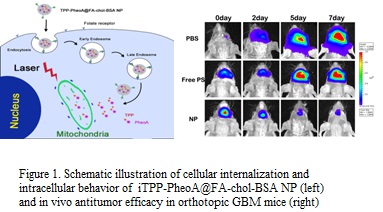
Young Tag Ko
Gachon University, South Korea
Title: Mitochondrial-Targeted Photosensitizer-Loaded Albumin Nanoparticle for Photodynamic Therapy of Malignant Brain Tumors
Biography
Biography: Young Tag Ko
Abstract
Introduction: Photodynamic therapy (PDT) is a promising approach for the treatment of serious disorders including cancer. The objective of this study was to develop a mitochondria-targeted photosensitizer (PS) for PDT. The PDT efficiency of PSs can be enhanced by improving its intracellular targeting ability. The lifetime of singlet oxygen generated from PS by light treatment is between 10–320 nanoseconds in the target area; therefore, its diffusion is only limited to approximately 10 nm to 55 nm in cells. Thus, the PS must be localized as close as possible to cellular organelles, such as the nucleus, mitochondria, and lysosome.

Methods: Herein, a porphyrin-derivative PS, pheophorbide a (PheoA), was conjugated to carboxybutyl triphenylphosphonium (TPP) via a carbodiimide linkage to enhance mitochondrial targeting and TPP-PheoA conjugate was further loaded into folate-cholesteryl albumin (FA-chol-BSA) nanoparticles (NPs) to improve its biocompatibility. In vitro and in vivo studies have been done in B16F10 and HeLa cancer cell lines and tumor-bearing mice, respectively, in the presence of laser irradiation. Furthermore, we generated orthotopic GBM xenograft mice by intracranially implanting luciferase gene transduced U-87 MG human glioblastoma cells and evaluated antitumor capacity of the NP in the tumor bearing mice. Real-time biodistribution was determined by monitoring the fluorescence of PS, and the growth of GBM after treatment was also determined by monitoring the bioluminescence signal from D-luciferin-luciferase using in vivo imaging system (IVIS).
Results: TPP-PheoA and TPP-PheoA@FA-chol-BSA NPs were readily taken up by B16F10 and HeLa cells. Further in vitro studies exhibited that TPP-PheoA and its nanoparticle primarily accumulate in the mitochondria, greatly generate ROS, lead mitochondrial disruption and cell apoptosis, and have higher phototoxicity against cancer cells. In vivo bioimaging and in vivo antitumor studies indicated that TPP-PheoA@FA-chol-BSA NP greatly accumulated in the tumor area and significantly suppress the tumor growth as compared to PheoA@FA-chol-BSA NP in tumor-bearing mice. TPP-Pheo@FA-chol-BSA NP also greatly accumulated in and significantly suppressed the growth of the brain tumor compared to the free PS and PBS in the orthotopic GBM model mice.
Conclusion: Taken together, TPP-PheoA@FA-chol-BSA NP could be a promising mitochondria-targeted PS for image-guided PDT and has great potential as a clinically applicable therapeutics for photodynamic therapy of GBM.

